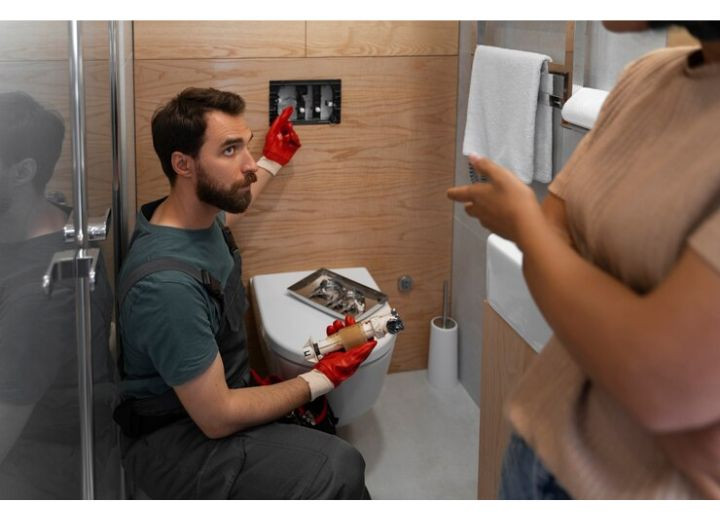How to Plan a Bathroom Remodel with Plumbing in Mind
Posted on August 28, 2024 by Admin

The planning stage of a bathroom remodel can be exciting, but it needs to be carefully considered, especially where plumbing is concerned. The secret behind a successful bathroom remodel lies in the balance between design aesthetics and the functionality required from the plumbing. Here's how to plan your bathroom remodel with plumbing in mind for a smooth, efficient renovation.
Assess Your Existing Plumbing System
Before designing your bathroom, take a closer look at your current plumbing. You should be aware of the layout of the pipes, drains, and the water supply lines. Check the lines for any leaks or other issues, and also check the aging parts that could be required to be changed. The assessment will let you know which parts of your plumbing can stay and which ones will have to change or be replaced.
Define Your Remodel Goals
Clearly define what your bathroom remodel is intended to do. Do you need to update the fixtures, change the layout, or add some new features? Most of your plumbing needs for this remodel will be driven by the goals you have set. For example, moving the sink or toilet will require that plumbing lines be relocated, which is often extremely complicated and expensive. By defining your goals, you can plan ahead for any plumbing changes required to execute your plan.
Consult a Professional Plumber
Engage the services of a professional plumber to discuss redesigning your bathroom. A licensed plumber can give important insight into the feasibility of your plans and provide insights into what plumbing changes are necessary to complete your bathroom remodel. They will also alert you to potential issues that you may not have noticed, which may cause expensive surprises at the beginning of renovation. This will ensure that all plumbing aspects of your remodel are done right and efficiently.
Plumbing Upgrades
One can also consider plumbing upgrades to give your bathroom a new look. With rapidly changing technology, newer plumbing systems offer numerous options to pick and choose for enhanced efficiency and effectiveness. Low-flow toilets and showerheads, for example, save water usage and thereby lower utility bills. Other examples are efficient water heaters or new pipes for much-improved functionality in your bathroom. These changes shall bring long-term benefits and increase the comfort and enjoyment of the bathroom.
Design with Plumbing in Mind
While designing your bathroom remodel, make sure to keep in mind your plumbing system. You can also make provisions in your new design for existing plumbing lines to avoid a lot of rework. Relocated fixtures should be mounted as close as possible to the original location to avoid any unnecessary plumbing costs or headaches. By proper planning, you will be able to include new design elements in your bathroom while maintaining a functional and efficient plumbing system.

Address Ventilation and Drainage
Among the more important features of any bathroom renovation job would be effective ventilation and drainage. If the bathroom has not undergone proper ventilation, moisture would accumulate, in which mold and mildew can thrive. Ensure that your renovation has appropriate solutions to vent it accordingly, like an exhaust fan. Next is to provide adequate drainage facilities to allow water to drain through without pooling or damaging the floor.
Budget for Unexpected Costs
Budgeting for unexpected plumbing costs is quite important when you are making plans for your bathroom remodel. It is quite common to discover hidden problems that may require additional repairs or adjustments when plumbing work is being done. Having a contingency fund will help you manage these unforeseen expenses without any disruption to your project.
Must Read : How to Address Plumbing Issues in Older Homes
Conclusion
A successful bathroom remodeling project will have to include plumbing in the overall plan. You will want to evaluate your current plumbing system, set clear remodel goals, consult with professionals, and think about any upgrades. Only careful planning and detailed attention to plumbing will bring you a much more efficient, comfortable, and enjoyable bathroom space.
Faqs
-
1. Why do I need to evaluate the current plumbing system before a remodel?
Understanding what's been there including the layout and condition of the existing pipes and fixtures will let you know if you have leaks or if some elements of your system are just too old to interface with your new design.
-
2. How can I define my goals for a bathroom remodel?
You will define your goals by deciding upon changes, such as upgrading the fixtures, adding new features, or reconfiguring the space. Having clear goals will help guide the design and plumbing plans to ensure the remodel meets your needs and expectations.
-
3. What role does a professional plumber play in a bathroom remodel?
An experienced plumber provides expertise when assessing your plumbing needs and the structural feasibility of changes, ensuring they are up to code. They will provide valuable insight into your plans for plumbing upgrades and be alert to issues that come up during the remodel.
-
4. What are some common plumbing upgrades that should be considered during a remodel?
Common plumbing upgrades include low-flow toilets and showerheads for water conservation, upgrading to a more efficient water heater, and changing out old or corroded pipes. This kind of upgrade can improve the performance, energy efficiency, and lower utility costs of your house.
-
5. How can I budget for unexpected plumbing costs during a remodel?
Create a slush fund in your remodeling budget that helps in paying unexpected plumbing expenses. This fund is especially helpful in covering unforeseen repairs or modifications that may be required during the remodel process and also allows for peace of mind in being able to manage additional expenses.
Recent Post
- Top Plumbing Service Providers in Arizona, USA
- Top 10 Electrician Service Providers in Alabama, USA
- Top 20 Roof Repair Service Providers in Alabama, USA
- The Role of Roof Insulation in Energy Efficiency: Tips and Tricks
- Understanding Roof Damage from Wildlife and How to Prevent It
- How to Choose the Best Roofing Contractor for Emergency Repairs
- Roofing Maintenance for Historic Homes: Preserving Architectural Integrity
- The Importance of Proper Attic Ventilation for Roof Health
- How to Identify and Prevent Roof Mold and Mildew
- The Best Practices for Removing Snow from Your Roof